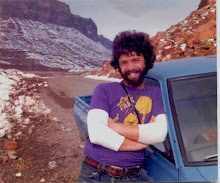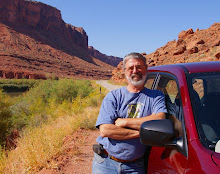
March 18 - From my quiet campsite in the heart of the Carrizo Plain, I watched the morning sun rise big and red through the smog and haze of the Central Valley. Once I packed things up and began driving north again, I left much of the bad air behind me. The fields of flowers became more dominant, many of them sparkling with dew. I was constantly stopping the car and getting out for the photo ops. My primary destination for the morning was Soda Lake and the Walker Creek area where an interpretive trail runs right along the San Andreas Fault.
The dirt road to the Walker Creek trailhead was unrelenting in its show of unbroken blooms of fiddlenecks, filaree and daisies. The show just kept getting better and better. The short trail leads to a point on Walker Creek where fault displacement has occurred over time and one can see the stream bed suddenly making a 90 degree turn to the right and then, in another 100 yards or so, making another 90 degree turn to the left; dynamic visual evidence of major movement along the San Andreas.
After six days of heading in a more or less westerly direction, I was finally heading east again. My rather unambitious goal for the day was to reach the desert town of Mojave where I had a motel room reserved. I had plenty of time to take it slow and easy. When I got onto the pavement again on Hwy.58, I left the Carrizo Plain behind me as I began an easy climb up and over the Temblor Range. Here too the flower displays were spectacular, enhanced by bucolic old ranch buildings and occasional groups of cattle. As I got closer to the town of Taft, these eventually gave way to stark, eroded hillsides decked with oil derricks and machinery.
The Carrizo Plain is a sad reminder of what much of the western San Joaquin Valley may have been like several generations ago. In places like Taft, McKittrick, and big daddy Bakersfield the current status of the valley is all too visible. Over-farmed landscapes. Oil rigs. Air pollution. Constant heavy traffic on Hwy. 99 & Interstate 5. And franchise food joints at every interchange. Industrial farming at its worst. I was determined to stay off of the main roads and headed instead for hwy. 223 toward Arvin and the Tehachapi Mountains.
Because of the heavy haze, I couldn’t actually see the Tehachapis until I had passed through Arvin where they began to loom impressively in the near distance. As soon as the highway began its climb into the mountains, I was treated to the site of vast orange splotches of poppies on the flanks of the hills and deep purple lupine in the pastures, the two species intermingling throughout with deep green grasses to create a quintessential California palette of colors. I remembered journal entries I had read from some of the earliest Spanish explorers who described a landscape knee deep in native flowers and vegetation, in the days before invasive grasses and star thistle.

Once I connected again with Highway 58 near Caliente, it was a roller coaster ride up and down in fast lanes of traffic, over the Tehachapi Summit and down the eastern side where the oaks and chaparral gave way to Joshua trees and a man made forest of gigantic windmills. As I pulled into Mojave in the late afternoon, I was met with a furious wind storm and sought shelter at the nearby Econo Lodge where another east Indian fellow graciously showed me to my room. There I took the opportunity to plug in and recharge my cell phone, camera battery and portable dvd player, all the important components of a modern day journey.
The manager told me that the best place in town to eat was Mike’s Cafe. If you’ve been to Mojave, you know this isn’t saying too much. Located on the main drag, the place fairly rattles when heavy trucks drive by. And with hardcore country music blaring from within, I knew I’d found the proper ambience for dinner. Furthermore, on a large shelf that circumnavigated the entire establishment was an incredible collection of vintage pedal car toys, at least fifty of them, probably worth more than the business itself. And there were more of those Mormon humor books about “Alzhimers” and raising kids and being married. It was an abrupt wake up call that I was back in the Mojave Desert again and that Death Valley National Park was a relative hop, skip and a kangaroo rat jump away.





No comments:
Post a Comment